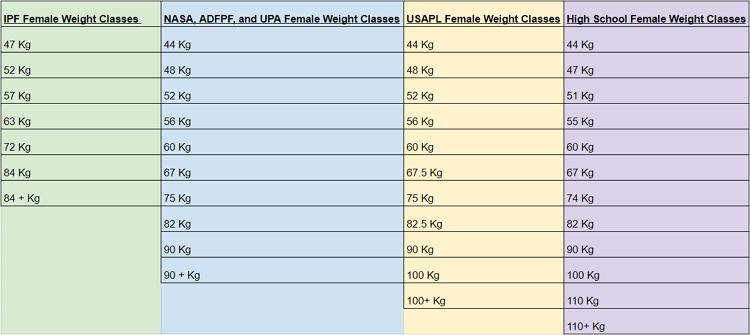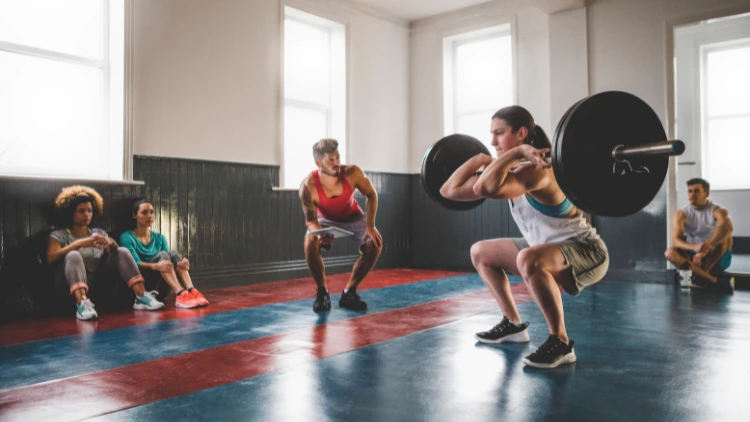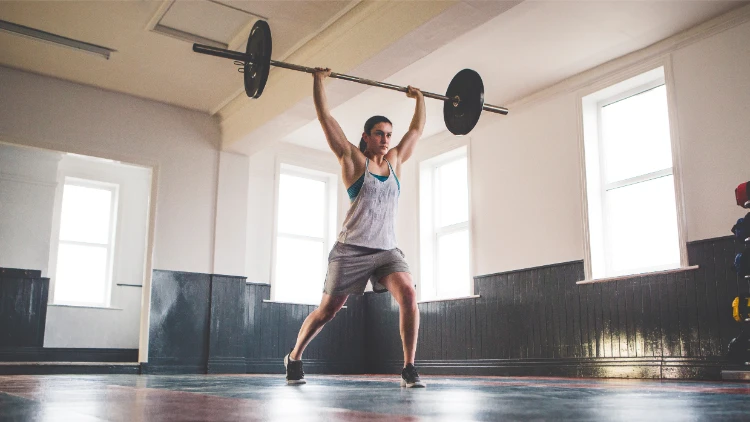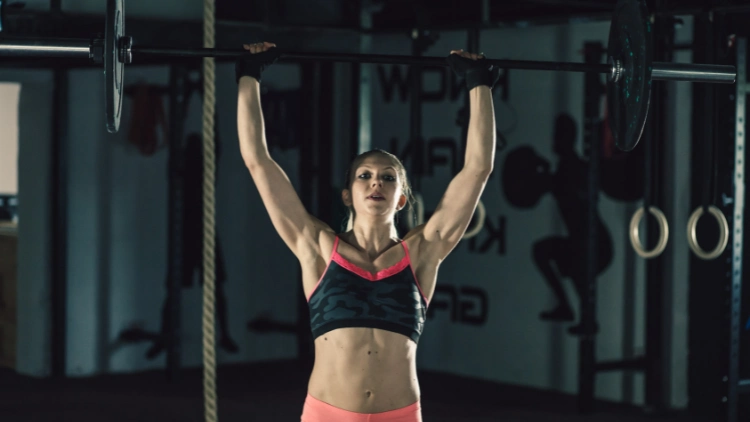
When it comes to powerlifting weight classes, women have to consider which federation they’ll compete in, what weight they’ll be able to get down to, and the average lifts of their competitors to truly decide where they’ll be most competitive.
Therefore, the data below can help any female powerlifter decide which weight class they should compete in, and to keep you inspired, we included 13 powerlifting tips from the best women in the sport.
Powerlifting Weight Classes: Women
Women are now more present in powerlifting, prompting the establishment of powerlifting weight classes for them, akin to those long-standing classes for men, recognized by key federations like the United States Powerlifting (USAPL) and the International Powerlifting Federation (IPF).
Powerlifting is not only competing in the 3 compound movements: squat, deadlift and bench press but competitors must compete within the same weight class to level the playing field between powerlifters. The practice was first started by men’s competitions and later adapted for women as the need presented itself. Women have lighter powerlifting weight classes and tend to transition slower than men between classes.

Source: SolStock via Canva.com1
These classes are updated every now and then to reflect the realities of the lifter’s needs and make the classes more feasible across the age ranges—this makes them more proportional thus making the weight classes more inclusive as the sport grows.
Weight classes are usually denoted in kilograms for women and they apply for those aged between 18 and 50. Anyone outside these ranges has less strict standards in regards to what classes they will fall under. Female weight classes typically range from a low of 44 kg to 100+ kg.
Female Weight Classes: USAPL (United States Powerlifting) & IPF (International Powerlifting Federation)
The USA powerlifting and IPF are the main benchmarks for female weight classes with the former recently updating their female weight classes. They also include height dimensions for the competitors alongside their weight.
USAPL Female Weight Classes
- 44 Kg
- 48 Kg
- 52 Kg
- 56 Kg
- 60 Kg
- 67.5 Kg
- 75 Kg
- 82.5 Kg
- 90 Kg
- 100 Kg
- 100+ Kg
IPF Female Weight Classes
- 47 Kg
- 52 Kg
- 57 Kg
- 63 Kg
- 72 Kg
- 84 Kg
- 84 + Kg
Typically, height is not usually a factor when a consideration is made for body weight classes unless they are very tall in the realm of anything close to 6 ‘2”—these should compete at a weight ideal for their body. Shorter people tend to be better lifters since more of the weight will be centered on muscle mass, tendons and ligaments as opposed to structural for tall people which includes bones.
Subsequently, this is most apparent at the elite level of competition. The table below gives the weight class and height that corresponds to it, but this applies only to elite levels of the competition.
| Weight Class (kg/lbs.) | Height (cm/inches) |
| 60/132 | 155/61 |
| 67.5/148 | 160/163 |
| 75/165 | 164/64.5 |
| 82.5/181 | 168/66 |
| 90/198 | 171/67.5 |
| 100/220 | 174.5/69 |
| 110/242 | 177.5/70 |
| 125+/275+ | 186/73 |
Other Federations’ Powerlifting Weight Classes Women
Besides USAP and IPF, various other federations uphold powerlifting weight classes for women. These include the Natural Athlete Strength Association (NASA), American Drug-Free Powerlifting Federation (ADFPF), 100% Raw, and United Powerlifting Association (UPA).
Natural Athlete Strength Association (NASA), American Drug-Free Powerlifting Federation (ADFPF), 100% raw and United Powerlifting Association (UPA) female weight classes appear below:
- 44 Kg
- 48 Kg
- 52 Kg
- 56 Kg
- 60 Kg
- 67 Kg
- 75 Kg
- 82 Kg
- 90 Kg
- 90 + Kg
In addition to these federations, there are high school federations that have weight classes for females. High school students both females and males have classes that complete in the 3 compound movements.
Just like in the adult competitions, competitors compete only within the same classes. There are both team and individual competitions and additional gear is allowed such as squat suits which are not in USAPL or IPF.
High school female weight classes appear below measured in kilograms:
- 44 Kg
- 47 Kg
- 51 Kg
- 55 Kg
- 60 Kg
- 67 Kg
- 74 Kg
- 82 Kg
- 90 Kg
- 100 Kg
- 110 Kg
- 110+ Kg
Powerlifting Weight Classes: Women’s Average Lifts
Powerlifting weight classes, both women and men included, have average lifts that serve as strength standards for a given lift. These averages provide a guideline to female powerlifters of what they should be able to lift in the respective category, be it bench press, squat or deadlift.

Source: SolStock via Canva.com2
They thus provide an excellent foundation to begin their powerlifting journey and subsequent weight goals as they progress and graduate to different classes.
There are 5 classes that are a female like a male powerlifter progresses through on their way to becoming the cream of lifters—these are:
- Elite female lifter—far from average which comprise the top 10% of female powerlifters and is 95% stronger than other lifters.
- Advanced female lifter—above average which comprise top 25% of female powerlifters and is 80% stronger than other lifters.
- Intermediate female lifter—average which comprise top 50% of female powerlifters and is 50% stronger than other lifters.
- Novice female lifter—below average which comprise top 75% of female powerlifters and is 20% stronger than other lifters.
- Beginner female lifter—far below average which comprise top 90% of female powerlifters and is 5% stronger than other lifters.
Female powerlifting weight classes average lifts reflect the one-rep max lifts (1RM)—which is the supreme standard for measuring muscle strength and is the maximum weight that can be lifted in one rep while maintaining perfect form and technique.3
The numbers denoting the average lifts and range that each class lifts based on body weight is derived using the 68–95–99.7 (empirical rule). In a normal distribution of data in this case, the one max rep weight, states that 68%, 95% and 99.7% of all values fall between 1, 2 and 3 deviations from the average (mean) value.4
In the powerlifting competition 68% (majority) of the lifters’ 1RM will be in the first deviation from the mean, and 95% in the second and 99.7% in the third both making the minority groups.
In other words, the majority of the lifters will fall in the largest weight deviation from the mean (68%), and in the extremes of the data set—beginners making a smaller percentage and the elite lifters capable of heavier weights making a small number as well.
A good analogy to better explain this would be when answering the question of the amount of people who can bench 225. The number is low as can be imagined, about 0.075% of the world’s population can! This would place these individuals in the third deviation from the mean, which is 99.7% at the extreme end.
To use this data in an efficient way, the female powerlifter must accurately determine their lean weight and therefore accurately know what average weight they should be able to lift to start from and subsequently advance to as they climb the classes. There are a number of methods that accomplish this including quantitative magnetic resonance (QMR)—the most accurate one being the use of bone density scan also known as the dexa scan.
Bone density scan popularly referred to as the dexa scan is an assessment of calcium and mineral composition of the bones to determine their strength and thickness.5 By measuring the bone density through this process, a true measurement of the lean mass is established as this scan provides a breakdown of total weight, fat mass, lean mass and the actual weight of the bones.
Female Squat Average Lifts by Weight Class
The below data provides the bench press averages for females based on their weight and the respective classes from beginner all the way to elite. Typically, the squat average is 90% of the deadlift average of the powerlift, known as the deadlift to squat ratio.

Female Bench Press Average Lifts by Weight Class
The bench press, a cornerstone of powerlifting, focuses on the upper body. Below are the average lifts, measured in pounds, distributed among the five classes.

Female Deadlift Average Lifts by Weight Class
The average powerlifting weight classes for women’s deadlifts specifically, are detailed in the table below and spread over 5 classes categorized by body weight.

Female Average Powerlifting Totals by Weight Class
The female average powerlifting totals represent the combined lifting potential across all compound movements. However, as seen from the data on bench, squat, deadlift ratio, these totals don’t match the individual averages for each compound movement.
Powerlifting totals are merely a reflection of the overall ability in all three lifts identifying weak points and strengths. It is possible for female lifters to be a novice in squats but be advanced lifters in the powerlifting totals which implies that they are better, more balanced lifters.

Required Equipment to Compete
One of the most important arsenal that a female lifter will need is the equipment that they use to complete their lifts—there are a number of equipment and gear that are allowed and recommended to effectively lift their weights such as t-shirts, belts, deadlift shoes and so on.
The following are the required equipment for female powerlifters:
- Deadlift shoes
- Squat shoes
- Belt
- Singlet
- T-shirt
- Underwear
- Chalk
- Deadlift socks
- Chalk
- Mouth guard
- Knee sleeves
- Wrist wraps
However, there are several equipment or gear that are prohibited by federations to ensure that the lifts are raw and therefore independent of aids—these include squat and deadlift suits, knee wraps, bands etc.
Powerlifting Shoes: Women Champion’s Favorites
Having the right shoes is crucial for female powerlifters, as powerlifting shoes ensure stability and enable the lifter to exert maximum driving force into the bar, resulting in efficient lifts. The shoes primarily used are the deadlift and squat shoes.
Squat Shoes
Good quality shoes for squats ensure a stable base that can allow the lifter to transfer force efficiently and provide mobility for a better squat. Among the favorite women’s champion’s shoes include:
- Adidas powerlift
- Reebok legacy lifter II and PR II
- Adidas adipower weightlifting II
- Inov-8 fastlift 360
- Nike romaleos 4
- Vibram fivefingers v-train 2.0
- Nike metcon 7
Deadlifting Shoes
Like squat shoes, proper deadlift shoes are essential for providing a stable base and enough grip to complete a successful deadlift. Unlike squat shoes, they should be flat and due to more hip flexion than knee, a drop from the heel to toe isn’t really required. These are the favorite deadlifting shoes for women champions:
- Sabo deadlift shoe
- Vans sk8 HI
- Converse Chuck Taylor
Top Powerlifting Programs: Women (Suitable Programs at Each Skill Level)
There are several powerlifting programs that women could embark on to get their powerlifting careers or training jumpstarted. Numerous powerlifting programs are tailored for men, reflecting their extensive experience in the sport, as evidenced by the array of powerlifting programs available. Women can essentially embark on these programs too because both regimens can be started since the goals may vary—therefore the same training programs can be used whilst having different goals.
Renowned powerlifter Stefi Cohen states that when it comes to exercises, both men and women can train the same exercises and maintain similar frequency and volume. Training frequency and volume refers to the amount of times a muscle is trained and volume the amount of training it actually receives which has an impact on muscle growth and strength.6
Having correctly identified their respective powerlifting weight classes, women may commence training programs designed for beginners, novices and experts.
Beginners
The list below gives a number of top powerlifting programs for female powerlifters who are getting started in powerlifting:
- Starting Strength Routine
- Jason Blaha’s Ice Cream Fitness 5×5 program
- John Shaeffer’s Greyskull LP Program
- Jonnie Candito Training
Novices
The programs below are for women who have already been powerlifting for between 6 and 24 months and are ideal to continue and add on to their journey in powerlifting:
- nSuns 531
- Texas Method Training
- Madcow 5×5 Workout Program
- Our 8 Week Powerlifting Program
- Our 6 Week Powerlifting Program
Experts
The programs below are for those that have reached training plateaus and typically have been training for 4-5 years—advanced and elite lifters stand the most to gain from these plans, they are:
- Juggernaut Method Strength Training Program
- Sheiko Program: Russian Powerlifting Training Routine
- nSuns CAP3
Advice From World Champion Powerlifting Women in Each Weight Class
For women looking for motivation, they need to look no further than those who have competed in the sport and have gone on to achieve phenomenal results.
Here are tips from 13 best powerlifting women that should give women the drive to soldier on and realize their dreams of becoming the best powerlifter they can be.
- Stefanie Cohen—Through experimentation, new things can be tried to find true passions; through failure, lessons are learned and constant learning is key.
- Amanda Lawrence—Amanda’s tip is for one to do their best and the success will follow.
- Meghan Scanlon—Meghan’s motivation to upcoming lifters is to have fun, finding what makes someone happy is what makes them tick and success will follow.
- Serena Abweh—Serena has overcome an eating disorder due to powerlifting and her inspiration is: nothing is more powerful than someone knowing their own true worth and finding strength from that.
- Daniella Melo—Daniella’s advice is that someone can’t rely on motivation, but can set goals for themselves and make sure to follow through with those goals to set up for success.
- Jen Thompson—Jen’s tip is to ensure a diet rich in protein and being cautious on carbs and fat.
- Heather Connor—Heather’s advice for new lifters is to erase all doubts that they may have, never compare themselves to others, set goals for themselves and chase them. They should prove to the naysayers that they can indeed accomplish the goals they’ve set for themselves.
- Jessica Buettner—She adheres to the saying, it’s not practice that makes perfect but perfect practice that makes perfect.
- Prescillia (Lya) Bavoil—Her motivation tip is to always be better, and not better than someone else but better than how she was yesterday or the months before.
- Megan Gallagher—She stresses a new lifter will not lose anything by trying, start slow and at a pace that’s comfortable and have lots of fun!
- Samantha Calhoun—Samantha’s tip to newbies is learn the sport, be a student and never be afraid of failure. Always strive for progress and try to accomplish goals, success naturally follows.
- Maria Htee—Maria’s tip for female powerlifters is to simply set small goals and enjoy the journey; the mind body combo can accomplish amazing things.
- Kimberly Walford—Kimberly’s motivational quote is having a relentless dedication to be the best athlete that she can be. Hard work always leads to results.
What Powerlifting Weight Class Is Best for You?
Knowing what powerlifting weight class is most ideal for the female powerlifter is crucial before properly embarking on a powerlifting program and subsequently making progress on it—this should be the first thing a female powerlifter investigates before starting a program. Weight classes are determined by the true lean mass of the lifters and are independent of the body mass index.

Source: fotostorm via Canva.com7
The body mass index (BMI) is an analysis of a person’s body fat content and is based on the height and weight.8 The most accurate way to measure the true lean mass of a female powerlifter that is independent of the body fat content is to complete the bone density scan (DEXA scan).
Knowing the lean mass would be key to pinpointing someone’s true weight class—it may be beneficial to lose weight in the interim to get to that true weight. Once this is done, a female powerlifter is in the driver’s seat to commence the program.
Powerlifting has been dominated by men for a long time, and many women who may have a spark of interest in the sport but are new to powerlifting may feel like they are entering a world alien to them and often intimidated by it.
Since powerlifting is about advancing and getting strong in the three compounds, this sets it apart from other workouts that revolve around aesthetic appeal and the subjective judging that goes along with it, which makes it a refreshing departure from this stereotype.
Many women have gone on to set a mark in powerlifting from Bonica Brown to Stefanie Cohen and they have continuously raised the bar setting new records.
As long as a woman is in a position to squat below parallel, successfully complete a deadlift or touch the bar when bench pressing, then she can get into powerlifting, even at the weight they are able to start with. Given proper coaching, equipment, adequate nutrition, relentless hard work, and unwavering dedication to the sport, any woman has the potential to become a successful powerlifter.
Powerlifting is fun and being stacked against other competitors gives even more motivation and drive. What’s more, there is no age limit on when to start and someone is neither too old nor too young to get started.
Female powerlifting encompasses all ages from youth starting at 8 eight years old to those who are over 40 years old and at the golden years of their lives—80 year old powerlifters have been spotted powerlifting!
For females desiring to get into powerlifting, identifying what powerlifting weight classes women should be categorized for their given weight and strength is a good foundation to know where to begin their journey and track the progress into this exciting world, and we hope the tips from 13 best powerlifting women inspire hope even if odds are stacked against you.
References
1SolStock. Canva. Accessed 13 April 2023. <https://www.canva.com/photos/MAEJfjxPlF0-professional-female-powerlifter-clean-lifting-heavy-weight/>
2SolStock. Canva. Accessed 13 April 2023. <https://www.canva.com/photos/MAEJKaSphrY-professional-female-powerlifter-doing-overhead-press/>
3Dong-il Seo, E. K.-k.-h. (2012, June 1). Reliability of the One-Repetition Maximum Test Based on Muscle Group and Gender. Retrieved 2022 <https://www.ncbi.nlm.nih.gov/pmc/articles/PMC3737872/>
4https://www.ncbi.nlm.nih.gov/pmc/articles/PMC3737872/ <https://en.wikipedia.org/wiki/68%E2%80%9395%E2%80%9399.7_rule>
5MedlinePlus. (2021, September 16). Bone Density Scan. Retrieved 2022, from <https://medlineplus.gov/lab-tests/bone-density-scan/>
6Eisuke Ochi, M. M. (2018, July 2). Higher Training Frequency Is Important for Gaining Muscular Strength Under Volume-Matched Training. Retrieved 2022, <https://www.ncbi.nlm.nih.gov/pmc/articles/PMC6036131/>
7fotostorm. Canva. Accessed 13 April 2023. <https://www.canva.com/photos/MAEJPqNcpN4-young-strong-female-powerlifter/>
8U.S. Department of Health & Human Services (2022). Calculate Your Body Mass Index. Retrieved 2022, <https://www.nhlbi.nih.gov/health/educational/lose_wt/BMI/bmicalc.htm>